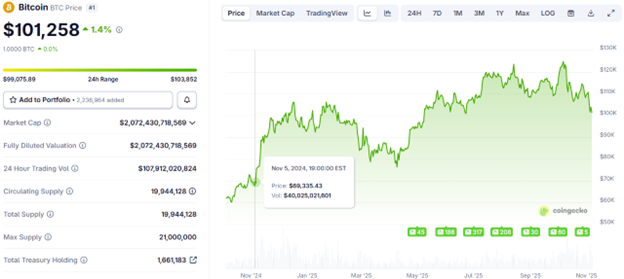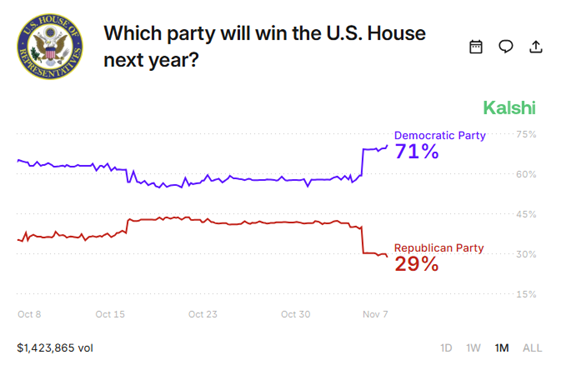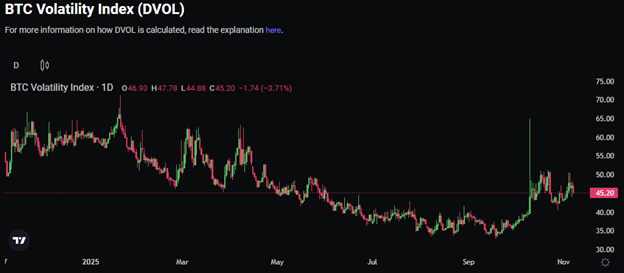Winds of Change
“The future's in the air, I can feel it everywhere, I'm blowing with the wind of change” - Scorpions, 1990
That was how the cryptoasset community felt after the US elections in November 2024. With a Republican president and legislators assuming office, years of regulation by enforcement and Operation Chokepoint 2.0 were about to be lifted. Fast forward a year later to November 2025, and we see a new wave of Democratic mayors and governors being ushered into office after the elections. In the evening, as the election polls were nearing their close, BTC dropped briefly below $100,000, over -7% on the day. Expectations are shifting.
In the one year from election day to election day, BTC has gained an impressive 46% to its current price of around $101,000.
Source: CoinGecko
While it had never dipped below its 04-November-2024 price of $69,335 since then, the path certainly has been volatile. Much of this volatility had been directly attributable to President Trump’s pronouncement of tariffs, first on Liberation in early April and then again in mid-October in response to China’s export controls on rare earths. This recent leg down on November 4, however, may be signaling a concern of a potential shift in tone from the top towards the crypto industry.
Not clear about CLARITY
In the 10 months since President Trump’s administration took office, the US crypto industry has made much progress on many fronts. Paul Atkins was sworn in as the Chair of the SEC in April. In mid-July, the GENIUS Act was signed into law and provided a regulatory framework for issuing stablecoins. Institutional adoption accelerated, manifesting in a variety of ways ranging from the issuance of spot ETFs for alt-coins and well over doubling of the value of real-world assets tokenized on-chain, to the securities issuance of Digital Asset Treasuries (DATs) as alternative vehicles for holding alt-coins.
However, for all its progress, the US crypto industry still doesn’t have a market structure bill. This is the purpose of the CLARITY Act. After passing the House with bipartisan support in July, the CLARITY Act is currently stalled in the Senate. The US government shutdown, which began on Oct 1, is only partly responsible. More significantly, the US Senators disagree on whether the SEC or the CFTC should be the regulatory body, how DeFi should be regulated, and investor protection among others [1, 2, 3].
Back in the Spotlight
The Democratic sweep on Election Day a few days ago brought a party reeling from its losses in 2024 back into the spotlight. Capitalizing on the uncertainty that President Trump has introduced to the US economy, international trade and relations, immigration, and in Democratic leaning cities, the Democrats won decisively on several ballots across the county including the New York City’s mayoral race, New Jersey and Virginia’s gubernatorial elections, and California’s proposition to redistrict the state.
It's too early to call with certainty what this implies for the US mid-term elections in 2026, but expectations that the Democrats will continue their momentum to win the House jumped immediately afterwards according to the predictions market.
Source: Kalshi
The Democrats, as a whole, have not embraced the cryptoasset ecosystem. As it stands now, the hold-up to the CLARITY Act in the Senate, shutdown notwithstanding, comes from a Democratic counterproposal for greater regulatory oversight of DeFi platforms for the purpose of preventing “illicit financing and regulatory arbitrage”. If this wasn’t enough, the party is also suspicious of President Trump’s arms-length relationship with World Liberty Financial and deeply concerned about aconflict of interest [4, 5].
If the record-breaking duration of the US government shutdown is any indication of the resolve of the Democratic party to pursue their party’s agenda, the November 4 election certainly strengthened their spine to stay their course.
Keeping our eyes on the ball
Predicting price levels is a bit of a fool’s errand. However, we do know that markets are forward looking and it’s evident that the celebratory sentiment in the crypto markets at the start of President Trump’s administration has given way to uncertainty. More recently, this has manifested in an uptick in BTC options implied volatility to the 45% - 50% range from a low of 35% just a month ago.
Source: Deribit
It’s hard to think there are any short-term fixes to this. After the fanfare in the US for the issuances for spot BTC and ETH ETFs, more recent issuances for SOL and LTC have gathered little media attention. The buzz around DATs, a concept pioneered by Strategy (MSTR), is quickly fading as their equity prices trade towards or below a 1 multiple of net asset value, making it difficult to raise capital and buy more cryptoassets. Legislative and policy progress will need to wait until after the government re-opens and even then, we are in serious need of compromises.
For digital assets and blockchain, it feels like the market and the development occupy two different worlds. The market, despite its upward march, is characterized by sharp pivots between FOMO and FUD. Meanwhile, development continues apace, steadily across different chains and applications, continuously 24/7/365, year after year. Scaling has improved, on-chain applications have real world utility, and the blockchain technology holds a strong promise to be a viable foundation for tomorrow’s financial infrastructure. While we’re cautious about this market heading into a more volatile period, we’re also keeping an eye on the opportunities out there.



